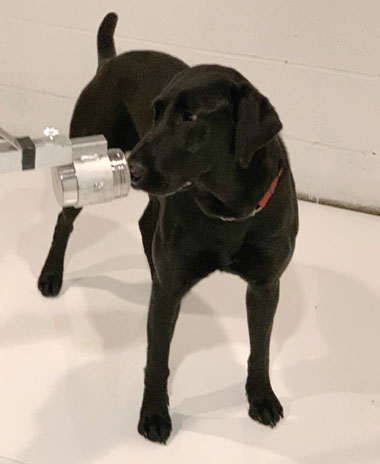
November 15, 2020
Researchers training dogs to identify people with COVID-19
Research teams in multiple countries are attempting to train dogs to identify people infected with SARS-CoV-2.
At least three projects are ongoing. Investigators at the National Veterinary School of Alfort in France are leading an international partnership to train and test dogs, some of which are now being used at Dubai International Airport in the United Arab Emirates. A project in Finland with the Faculty of Veterinary Medicine at the University of Helsinki has deployed dogs at the Helsinki-Vantaa Airport. And officials from the University of Pennsylvania School of Veterinary Medicine and U.S. Army are collaborating on a project with promising initial findings and plans for further testing.

Results reported so far indicate dogs can be trained to detect volatile organic compounds produced by infected individuals, including those with asymptomatic and pre-symptomatic infections.
Sniffing with accuracy
Dr. Anne-Lise Chaber, an epidemiologist and one-health lecturer at the University of Adelaide School of Animal and Veterinary Science in Australia, is leading a team that is a part of the international project coordinated by Alfort. As her team prepared to start training and testing dogs in early October, she noted study results from the partnership already indicate trained dogs can identify scents produced by the human body during SARS-CoV-2 infection and distinguish them from scents produced during infections with other betacoronaviruses or influenzalike illnesses.
“Preliminary results suggest that the dogs are not responding to other infections,” she said. “So, the volatile organic compounds that are being produced with SARS-CoV-2 are different than what is being produced if you got the flu and even different than what is produced when you get a cold.”
Dr. Chaber said the project’s dogs seem to be able to detect SARS-CoV-2 infections earlier than polymerase chain reaction–based assays, starting as soon as virus replication begins.
The Alfort team described those early results in a preprint article posted June 5 on BioRxiv. Their results, which had not yet been peer reviewed, indicate detection dogs repeatedly signaled that two perspiration samples had come from people with SARS-CoV-2 infection even though they had been negative by PCR assay. Retesting showed those people were infected.
The Alfort-led partnership also includes researchers in Argentina, Belgium, Brazil, Chile, Lebanon, and the United Arab Emirates.
Potential for use in many settings
In late September, four dogs began work at the Helsinki-Vantaa Airport, where passengers and airport personnel could volunteer to swipe their skin and drop the samples into containers that would be brought to a dog waiting with a trainer on the other side of a wall, according to an announcement from the University of Helsinki. A related announcement from airport operator Finavia includes a photo of a person swiping the skin on a wrist.
People with positive results are directed to a nearby university hospital health information station.
Citing previous studies, the announcement indicates trained dogs are able to find 94%-100% of people with infections, depending on the dog. University of Helsinki officials also see potential that COVID-19 detection dogs could identify infections in nursing and retirement homes and medical settings.
Their research will include studies on what the dogs are identifying in patient samples and how long that smell remains after infection passes, according to an announcement from May.
Study in the U.S.
Information from the U.S. Army Combat Capabilities Development Command Chemical Biological Center suggests dogs trained in the U.S. could be used to screen crowds at airports, stadiums, or borders. Dr. Patricia Buckley, chief of the Chemical Biological Center Biochemistry Branch, said in an email that dogs in a proof-of-concept study were able to discriminate between urine samples from people positive and negative for COVID-19, and the project was entering a second phase of training involving perspiration samples.
That second stage is funded by the federal Domestic Preparedness Support Initiative and COVID-19 Pentagon Task Force.
Dr. Buckley said researchers with the Army and Penn Vet did not yet know whether their dogs could distinguish between infections with SARS-CoV-2 and other respiratory illnesses. But she said further refinements in the project’s training protocols likely would involve training the dogs to ignore samples from patients with other illnesses.
A spokesperson for Penn Vet said Dr. Cynthia Otto, who is leading the study at the university, was unavailable to discuss the project while she completed a manuscript summarizing results from the first phase of the study, and nobody else with the university would be available. A previous announcement states that Dr. Otto leads a multidisciplinary research group for the study, which involves the Penn Center for Research on Coronavirus and Other Emerging Pathogens, the Perelman School of Medicine, the Hospital of the University of Pennsylvania, the Children’s Hospital of Philadelphia, and Penn Arts and Sciences.
The right dogs and training
Dr. Chaber, of the Australian team, hoped her project’s dogs could start a deployment trial in December or January. But she said progress would depend on how quickly hospitals sent perspiration samples from COVID-19 patients.
Dr. Susan Hazel, senior lecturer at the University of Adelaide School of Animal and Veterinary Sciences, is aiding Dr. Chaber’s work as an expert on animal behavior and welfare. She said the training involves standard detection dog protocols that use toys or food to reward dogs when they sit in front of positive samples rather than negative ones. That training requires exposing dogs to perspiration samples from COVID-19–positive people from varied demographic backgrounds and environments.
All of the candidate dogs will smell the odors distinctive to COVID-19, she said, and the difficulty lies in training them how to react to samples.
“The difficulty is in all the training you have to do around it so they can reliably indicate to the handler when they’re positive,” Dr. Hazel said. “And some dogs, temperamentally, might not be suited to the work itself.”